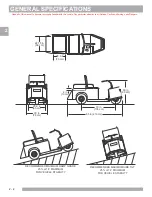
4 - 3
OPERATING PROCEDURES
Read all of this manual to become thoroughly familiar with this vehicle. Pay particular attention to all Notices, Cautions, Warnings, and Dangers.
4
Hydrogen gas is generated in the charging cycle of batteries and is explosive in concentrations as low as 4%.
Because hydrogen gas is lighter than air, it will collect in the ceiling of buildings necessitating proper ventilation. Five
air exchanges per hour is considered the minimum requirement.
Never charge a vehicle in a hazardous area or area that is subject to flame or spark. Pay particular attention to natu-
ral gas or propane gas water heaters and furnaces.
Before a new vehicle is put into operation, the items shown
in the
INITIAL SERVICE CHART
must be performed.
The vehicle batteries must be fully charged before initial
use.
Check for leaks that could have developed in shipment
from the factory.
Check for correct tire inflation. See GENERAL SPECIFI-
CATIONS.
Check the operation of the vehicle brakes, including the parking brake, make adjustments if necessary.
Remove the protective clear plastic from the seat bottom and back rest before placing the vehicle in service
ON-BOARD CHARGER
Risk of electric shock. Connect charger power cord to an outlet that has been properly
installed and grounded in accordance with all local codes and ordinances. A grounded
outlet is required to reduce risk of electric shock – do not use ground adapters or modify
plug. Do not touch uninsulated battery terminal.
Do not open or disassemble charger. Do not operate charger if the AC supply cord is
damaged or if the charger has received a sharp blow, or otherwise damaged in any way –
refer all repair work to qualified personnel. Not for use by children.
To prevent a physical hazard that could result in an electrical shock or electrocution, be sure that
the charger plug is not damaged and is inserted fully into a grounded receptacle.
The power (AC) cord is equipped with a grounded plug. Do not attempt to pull out, cut or bend
the ground post.
The on-board charger is located under the seat, it is wired
directly to the batteries. Before charging the batteries park
the vehicle in a well ventilated area, set the parking brake,
turn the key switch to OFF and remove the key. Pull char-
ger pigtail (P) out, connect the AC charging cord to the pig-
tail and plug into a dedicated 15 amp AC outlet to start the
charger.
When the charging cycle is complete, disconnect the AC
cord and replace the pigtail and the AC charging cord in
the storage area (S) provided.
ITEM SERVICE
OPERATION
Batteries Charge
batteries
Backrest Remove protective plastic covering
Brakes
Check operation and adjust if necessary
Tires
Check air pressure (see SPECIFICATIONS)
P
S



































